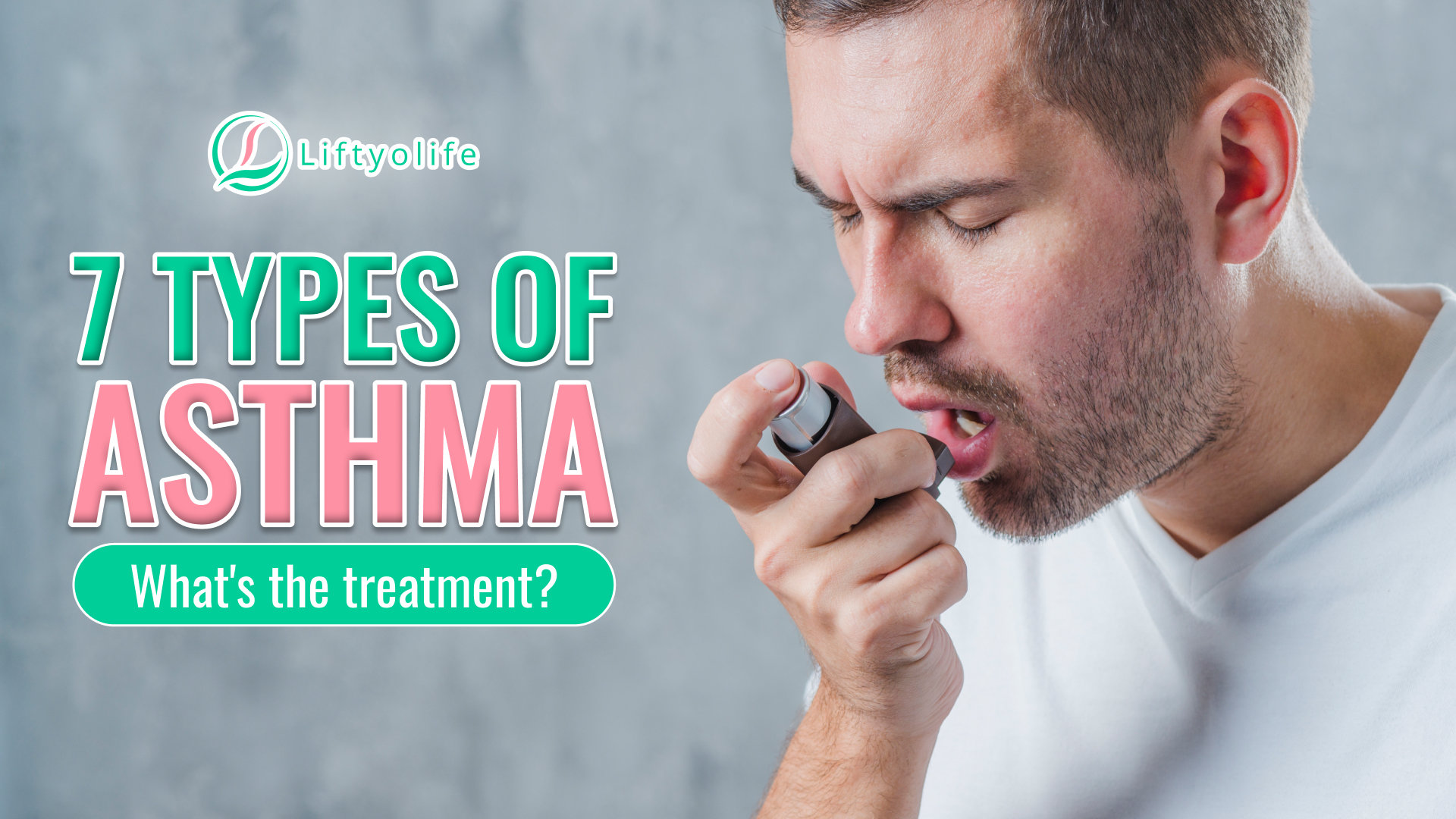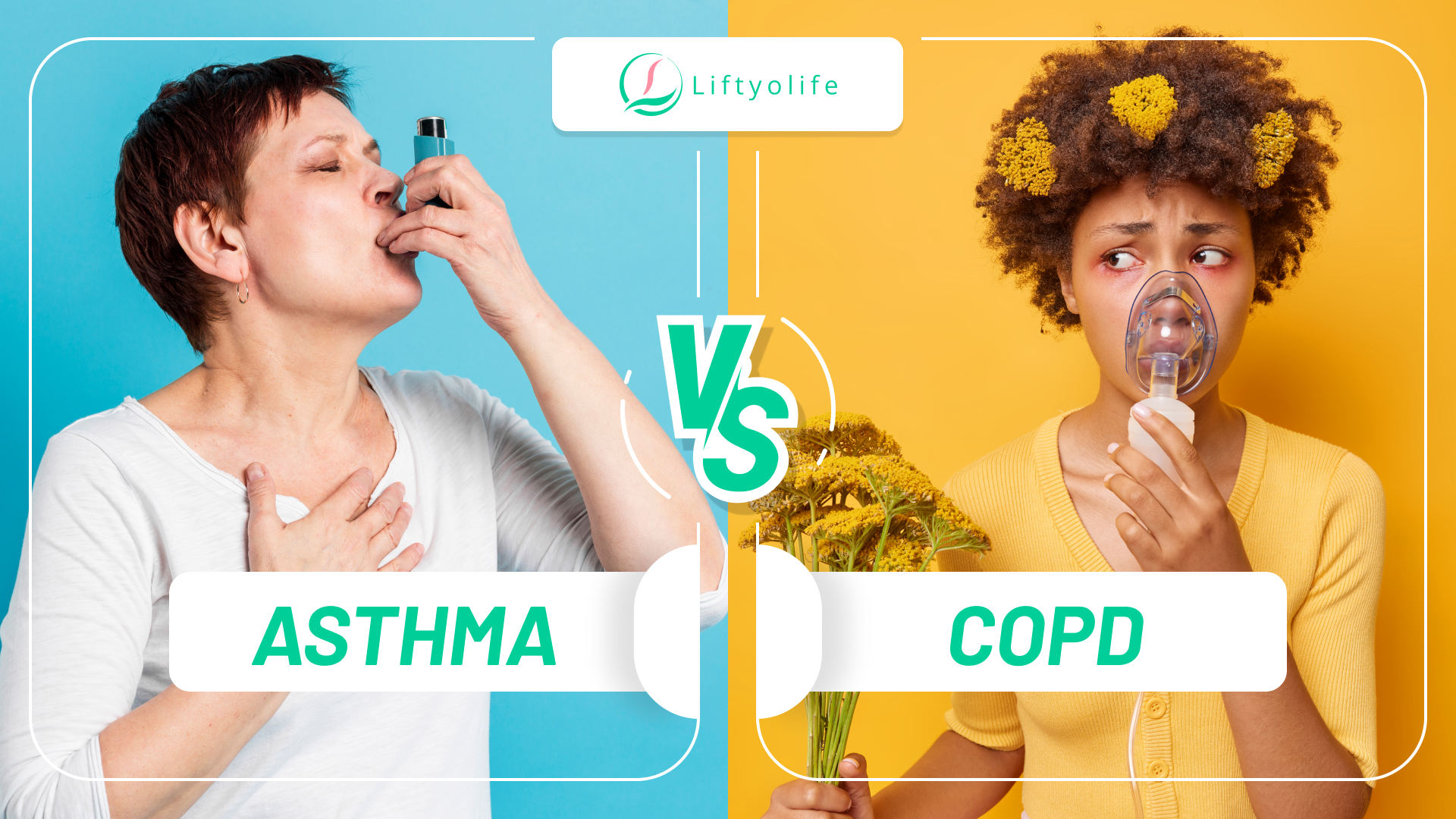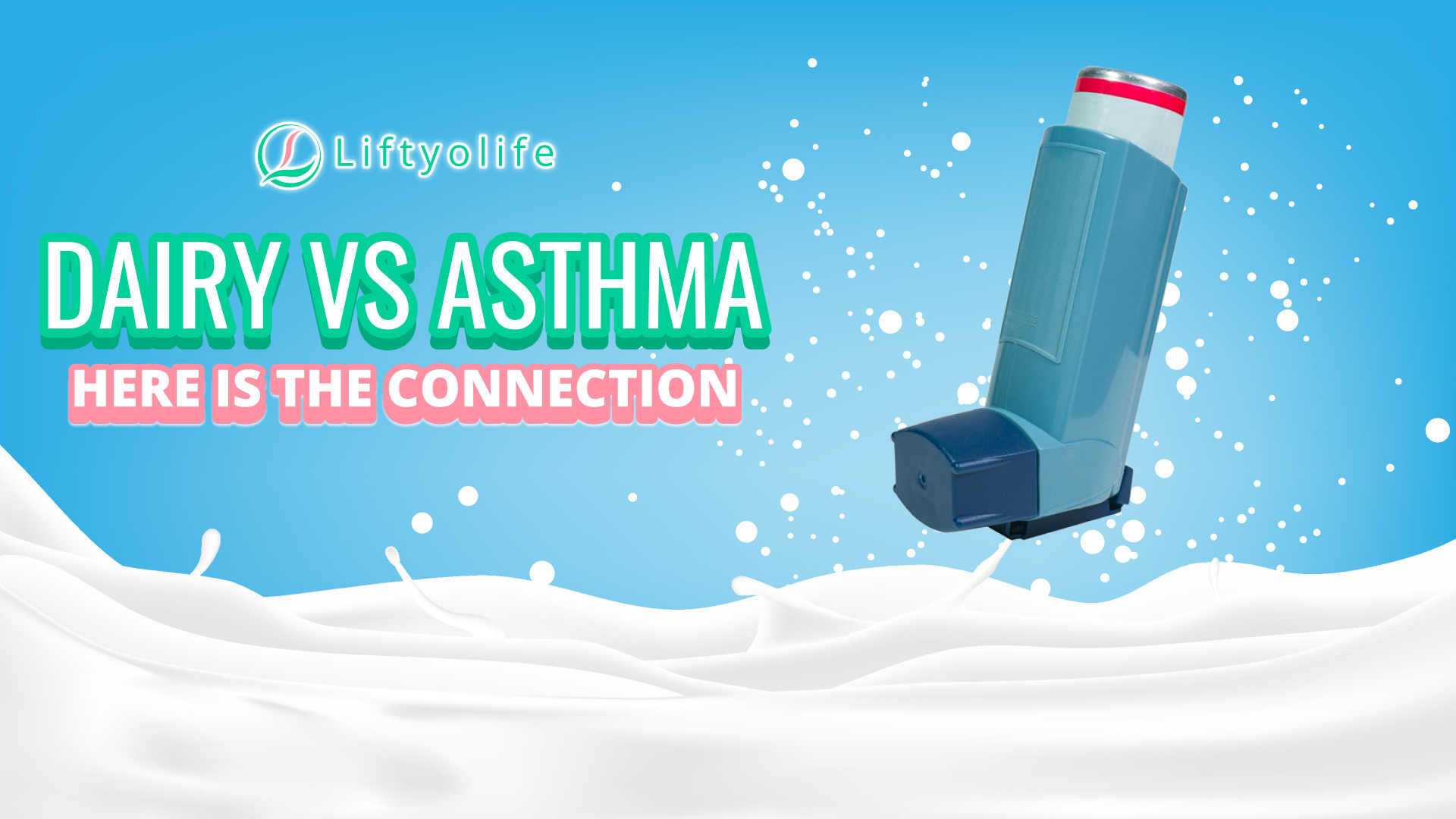Different Types Of Asthma: Symptoms & Treatment

Different types of asthma here will assist you and your doctor in determining the most effective treatment regimen. Although asthma cannot be cured or eliminated forever, appropriate treatment can control asthma attacks and allow you to live an active life with this disease. If you have asthma, prepare a positive attitude to deal with and overcome it. Liftyolife (liftyolife.com) is here to lift your spirits.
1. What’s asthma?
Asthma is a chronic (never-ending) disease that affects the airways and lungs. In other words, the airways in the lungs become narrowed due to inflammation and muscle tightening around the small airways (1). This chronic condition does not go away on its own and requires ongoing medical intervention.
Asthma affects approximately 25 million Americans. This equates to roughly one in every thirteen Americans, including 8% of adults and 7% of children. Moreover, this disease affects approximately 20 million adults in the United States aged 18 and up (2). Adult women are more likely than adult men to suffer from asthma.
2. Symptoms and causes of asthma

Symptoms and causes of asthma
2.1. What are asthma symptoms?
Most asthmatic children and adults experience difficulty breathing at times. Some people with severe asthma may have trouble breathing most of the time. Asthmatics typically exhibit obvious symptoms. These symptoms are:
- Tightness, pain, or pressure in the chest (it may feel like a band is tightening around it).
- Breathing difficulty.
- Coughing (especially at night).
- Sneezing (a whistling sound when breathing).
A variety of factors can cause these symptoms, but they are more likely to be caused by asthma if they:
- Occur frequently and continue to reoccur.
- Worse at night and early in the morning.
- Appear to occur due to an asthma trigger, such as exercise or an allergy (such as pollen or animal fur).
You may experience various signs at various times instead of all of these symptoms if you have asthma. In addition, symptoms can vary between asthma attacks.
2.2. What causes asthma?
Asthma has been linked to genetics, pollution, and modern hygiene standards, but there isn’t enough evidence to know if any of these factors are to blame. However, these certain factors that pose a higher risk can explain why some people have asthma while others do not:
- Genetics: Individuals with a family history of asthma are more likely to develop the disease.
- Allergies: If you suffer from allergies, you are more likely to develop asthma.
- Environmental factors: Infants can develop asthma after inhaling irritants to the airways. Allergens, secondhand smoke, and viral infections are examples of these substances. They can be harmful to infants and young children whose immune systems are still developing.
- Respiratory infections: Certain respiratory infections, such as a respiratory syncytial virus (RSV), can harm the developing lungs of young children.
Who is in danger?
Many elements can go up to your chances of developing asthma. These are some examples:
- An allergy-related condition, such as eczema, food allergies, or hay fever.
- Having a history of asthma or atopic diseases in one’s family.
- Having had bronchiolitis .
- Exposure to tobacco smoke as a child.
- Mother smoking in pregnancy.
- May be at risk of developing asthma due to their job.
- Being born prematurely (before 37 weeks) or with low birth weight.
Asthma caused by work
Asthma is sometimes linked to substances you may be exposed to at work. This is referred to as occupational asthma. The following are some common causes of occupational asthma:
- Grain dust and flour.
- Isocyanates (chemicals found in spray paint).
- A cacophony (a substance found in solder fumes).
- Wood ash.
- Latex.
- Animals.
Nurses, bakers, food processing workers, chemical workers, pastry chefs, animal handlers, welders, timber workers, paint sprayers are all examples of people who may be more vulnerable to these substances.
2.3. What are common asthma attack triggers?
Triggers can differ from person to person. However, some common triggers include:
- Colds and flu are examples of infections.
- Emotions – such as stress or laughter.
- Medications, particularly anti-inflammatory pain relievers like ibuprofen and aspirin.
- Temperature changes, cold air, wind, thunderstorms, heat, and humidity are all examples of weather.
- Air pollution: A variety of sources, including factory emissions, car exhaust, and wildfire smoke.
- Mold can grow in damp areas. Asthmatics may experience difficulties as a result. You don’t need to be allergic to mold to have an allergic reaction.
- Dust mites: You can’t see them, but they’re everywhere. Dust mites can trigger an asthma attack if you are allergic to them.
- Exercising can trigger an attack on some people.
- Cockroaches, mice, and other household pests can all trigger asthma attacks.
- Tobacco smoke: Quitting smoking is the best solution.
- Pets: Asthma attacks can be triggered by your pets. Breathing in pet dander (dried skin flakes) can irritate your airways if you are allergic to it.
- Strong chemicals or odors
- Certain occupational hazards.
3. Different types of asthma
3.1. Allergic asthma
Allergic asthma is the most common type, affecting ranging from 50% to 80% of asthma in the United States (3). Allergic (or atopic) asthma is caused by pollen, pets, and dust mites. Approximately 8 out of 10 people with allergic asthma also have another allergic condition, such as eczema, allergic rhinitis, or a food allergy.

Allergic asthma
Triggers of symptoms
According to the Asthma and Allergy Foundation of America, common allergens include:
- Pollen.
- Mold spores.
- Foods include milk, eggs, and certain nuts.
- Pet dander.
- Dust mites, cockroaches, and cockroach feces.
- Heavily fragranced products, such as perfumes.
- Airborne irritants, such as tobacco smoke and automobile and chemical fumes.
Additional symptoms
Allergy symptoms accompany classic asthma symptoms, such as:
- Congestion in the nose.
- Throat irritation.
- Running nose.
- Sneezing.
- Eyes are itchy, red, or watery.
Additional diagnostic Tests
The following tests confirm allergic asthma and identify your triggers:
- Blood tests: An allergic reaction is confirmed by elevated levels of immunoglobulin E (IgE) antibodies, which your body produces in response to allergens.
- Skin tests: Common allergens are applied to your skin to see if you react to them.
Treatment
You’ll have to deal with both asthma and allergies. This may entail avoiding triggers, taking allergy medication (antihistamines), or receiving allergy shots (immunotherapy).
The following suggestions may also assist people with allergic asthma in avoiding common allergens:
- Vacuum and dust regularly remove allergens such as pet dander, dust mites, and cockroaches.
- Pets should not be allowed in bedrooms.
- When air pollution levels are high, avoid going outside.
- Milk, eggs, peanuts, shellfish, and tree nuts, including hazelnuts, walnuts, and almonds, are foods that can cause allergic reactions.
- Reduce your use of harsh chemicals and highly scented products at home.
3.2. Nonallergic asthma
Nonallergic or intrinsic, asthma does not require the presence of an allergen to cause an attack. Nonallergic asthma affects between 10% and 33% of all people with asthma. It is more likely to manifest in adulthood and affects women more than men.
Symptoms triggers
A variety of factors can trigger nonallergic asthma symptoms, including:
- Cold weather.
- Humidity.
- Stress.
- Exercise.
- Acid reflux/heartburn.
- Pollution, smoke, or other airborne irritants.
- Respiratory infections.
- Sprays with strong odors.
Risk factors
Nonallergic asthma can be caused by a variety of factors, including:
- Pollutants in the air.
- Smoke.
- Stress.
- Exercise.
- Respiratory infections.
- Environmental tobacco smoke.
- Infections caused by viruses.
- Other medical issues: Nonallergic asthma patients are frequently affected by rhinosinusitis (inflammation of the nasal and sinus cavities) and gastroesophageal reflux disease (GERD), which may contribute to the development of the disease.
Additional diagnostic tests
No test can precisely diagnose nonallergic asthma. Skin and blood tests may be used to rule out allergies in the diagnosis.
Additional therapies
You may not require any treatments other than those commonly prescribed for asthma.
Some people with nonallergic asthma, on the other hand, do not respond well to inhaled corticosteroids (ICS). These medications are used as daily preventive medication for people with moderate-to-severe asthma.
If ICS do not work for you, you may require other preventive medications such as:
- Leukotriene modifiers.
- Long-acting beta-agonists (LABAs).
- Long-acting muscarinic antagonists (LAMAs).
3.3. Nocturnal (nighttime) asthma
Nocturnal asthma, which causes symptoms such as chest tightness, shortness of breath, coughing, and wheezing at night, can make it difficult to sleep and leave you tired and irritable during the day.

Nocturnal (nighttime) asthma
The exact reason why asthma worsens during sleep is unknown. Still, theories include:
- Increased allergen exposure.
- Cooling of the airways.
- Being in a reclining position.
- Hormone secretions that follow a circadian pattern.
Changes in bronchial function may even occur during sleep.
Nocturnal asthma affects more than half of all adults with asthma. This type of asthma affects approximately 10% of children.
Triggers of symptoms
Irritants such as pet dander or dust in your bedroom, as well as sleeping with the window open, can all be environmental symptom triggers.
Additional symptoms
The symptoms of nocturnal asthma are the same as those of classic asthma. They are more visible at night.
Sleep disruptions caused by nocturnal asthma can make you tired during the day. You may notice that you are waking up several times during the night. However, many people quickly return to sleep and do not recall waking up.
Nocturnal asthma can put you at risk of severe complications such as heart disease, respiratory arrest, and asthma-related death (Greenberg, 2012).
Causes and risk factors
Nocturnal asthma is thought to be caused by changes in your body during the night.
Your internal body clock, or circadian rhythm, contributes to nocturnal asthma by causing night time shifts in:
- Control of the muscles.
- Resistance to airway passage.
- Inflammation.
- Hormones.
Additional diagnostic tests
Testing your breathing during the day is ineffective in detecting nocturnal asthma. As a result, your doctor may ask you to test your breathing at home, close to bedtime. Depending on your symptoms, you may be referred for a sleep study (Global Initiative for Asthma, 2019).
Treatment
The same medications are used to treat nocturnal asthma for classic asthma. However, your medicine may need to be taken at a different time.
Instead of taking a daily control medication in the morning, you could take it in the afternoon or early evening.
Some researchers have proposed time-release tablets as a treatment for this type of asthma.
3.4. Cough-variant asthma
Cough variant asthma (stand for CVA) is a type of asthma that only manifests as a cough, one of the most common causes. The main symptom of this type is a dry cough. It could be your only symptom. Alternatively, if it is not adequately treated, you may develop other symptoms. More importantly, 30 to 40% of adult patients with CVA may progress to classic asthma if not adequately treated (7).

Cough-variant asthma
Triggers of symptoms
Keep an eye out for coughing fits that:
- Wake you up
- Come after exercise
- Worse in the cold, dry weather
- Worse if you have hay fever or are allergic to something else.
Factors of risk and causes
CVA may be an early symptom of developing asthma; children are more likely to have it than adults.
Additional diagnostic tests
CVA is difficult to diagnose. Order a sputum test in addition to standard asthma tests to look for white blood cells, which are often elevated in asthma patients.
Additional treatment
CVA is cured in the same way as other types of asthma.
3.5. Exercise-induced bronchoconstriction
Exercise-induced asthma (EIB) occurs when symptoms worsen during or immediately after strenuous exercise or other strenuous activity. This could happen 5–20 minutes after the workout. Although shortness of breath is common after exercise, EIB can also cause coughing, wheezing, and mild to severe chest pain. Around 90% of people with asthma also have exercise-induced asthma, with most cases being mild and responsive to treatment.
Triggers of symptoms
Your bronchial tubes (airways) are narrow when you exercise with EIB. Rapid breathing during exercise is thought to dehydrate the bronchial tubes, causing them to constrict (8). Symptoms typically begin during exercise but may worsen for 10 to 15 minutes after stopping. They usually go away after about 30 minutes. However, using your rescue inhaler is preferable to waiting to see if you improve without it.

Exercise-induced bronchoconstriction
When combined with exercise, certain factors may increase the likelihood of EIB. They are as follows:
- A cold environment or cold weather (such as in a skating rink).
- Swimming pool chlorination.
- Hot air (such as during hot yoga).
- Air pollution or other irritants in the air.
- Perfume, paint, cleaners, and new carpet or exercise equipment odors.
- Pollen count is high (especially if you also have allergic asthma).
- Recent respiratory illness or asthma attack.
EIB is less likely to be triggered by low-intensity activities (walking, hiking) or sports with short bursts of exertion (baseball, wrestling, gymnastics).
Additional symptoms
EIB can cause a few symptoms that are not common in asthma, such as:
- Reduced endurance
- Stomachache
- Throat discomfort
Causes and risk factors
Minor irritation or dehydration from exercise may cause EIB if you have asthma. In this case, the underlying cause of EIB is asthma (9).
While exercising, repeated exposure to cold, dry air or airborne irritants may damage bronchial tubes and cause EIB in people who do not have asthma.
Additional diagnostic tests
To determine if you have EIB, measure your breathing before and after exercise.
They will measure your forced expiratory volume (FEV1), which is the amount of air you can push out of your lungs.
Then you’ll exercise under supervision while your FEV1 is measured again. EIB is generally diagnosed with a 15% or more significant decrease.
Treatment
Asthma medications can often effectively treat the symptoms. However, if people’s symptoms aren’t responding to regular medication, they should see a doctor.
The following suggestions may also help:
- Use an inhaler before exercise and keep it nearby while exercising.
- Activity should be avoided if you have a viral infection.
- Warm-up before you exercise to help loosen up your airways.
- Cool down after workout to allow your breathing to slow down gradually.
- When exercising outside, cover your nose and mouth with a scarf.
- Exercises that cause labored or heavy breathing should be avoided.
Use a rescue inhaler or a long-acting inhaler before exercise to prevent attacks.
3.6. Occupational asthma
Occupational asthma (OA) is asthma caused by your job. People who have this disease may notice that their symptoms worsen while at work or improve when they take time off.
Indeed, up to 15% of asthma cases in the United States may be caused by occupational exposure to paint chemicals, insecticides, aerosols, or other harmful substances.
The time it takes for symptoms to appear may be determined by the level of exposure to these and other substances. Some people may experience an asthma attack within 24 hours of being exposed. In others, symptoms may not appear for months or even years.
Triggers of symptoms
Over 250 substances are thought to cause or trigger OA symptoms. Typical triggers include:
- Animals
- Cleaning supplies
- Molds of various types
- Wood, flour, or grain dust
- Insects
- Hydrochloric acid, sulfur dioxide, and ammonia are examples of chemicals.
- Latex
- Paints
Causes and risk factors
OA is caused by repeated exposure to fumes, gases, dust, or other irritants. Your airways are either directly damaged or become sensitized to the offending substance due to the exposure.
- Bakery.
- A pharmaceutical manufacturing facility.
- Manufacturing plant for detergents.
- Laboratory for Farm Grain Elevators (especially those that involve animals).
- Mills Plastics manufacturing plant.
- Metal-processing plants.
- Workshop for woodworking.
Additional diagnostic tests
Begin looking into possible work-related causes. The following steps may be taken:
- A blood test or skin test can be used to detect the allergen.
- Bronchoprovocation (inflammation of the airways) with the suspected trigger to see if your lung function drops by at least 20%.
- Breathing tests throughout the workday.
- Sometimes OA is misdiagnosed as bronchitis. Bring this up with your healthcare provider if you’ve been diagnosed with bronchitis, but your treatment isn’t working, and your symptoms seem to be worse at work than elsewhere.
Treatment
People who have OA should see a doctor or a healthcare provider. This will assist them in determining what is causing their symptoms, avoiding further exposure, and relieving their symptoms.
They should take any prescribed medication as directed by a doctor or specialist.
3.7. Adult onset asthma
Asthma typically begins in childhood, but some people are diagnosed with asthma for the first time as adults. This is referred to as adult-onset or late-onset asthma.
Adult-onset asthma can be caused by a variety of factors, including:
- Occupational asthma accounts for 9-15% of adult-onset asthma.
- Tobacco and secondhand smoke.
- Obesity.
- Female hormones have been linked to adult-onset asthma and maybe one of the reasons women are more likely than men to develop it.
- Stressful life events.
Five steps to effectively managing your asthma
- Use an asthma action plan to keep track of your symptoms.
- Use your preventer inhaler every day, even if you’re feeling fine.
- Take your reliever inhaler with you at all times.
- Examine your inhaler technique.
- Schedule an annual asthma review.
4. Diagnosis and tests
The following are the primary tests used to aid in the diagnosis of asthma:
- Spirometry: Spirometry is a test in which you blow into a machine that measures how quickly you can expel air and how much air you can hold in your lungs.
- FeNO test: The FeNO test involves breathing into a machine that measures the nitric oxide’s level in your breath, which is a sign of pulmonary inflammation.
- Peak flow test: You blow into a handheld device that measures how fast you can breathe out, and this may be repeated several times for a few weeks to see if it changes.
- X-ray or allergy tests: After being diagnosed with asthma, you may be subjected to a chest X-ray or allergy tests to determine whether an allergy leads to your symptoms.
5. Asthma management and treatment
- Anti-inflammatory medications: These medications help reduce swelling and mucus production in the airways. They facilitate the passage of air into and out of your lungs. Your doctor may prescribe them to you daily to control or prevent your symptoms.
- Bronchodilators are medications that relax the muscles that surround your airways. The relaxed muscles allow the airways to move. They also make it easier for mucus to move through the airways. These medications relieve your symptoms as they occur.
- Biologic therapies: Biologic therapies may be used when asthma symptoms persist despite proper inhaler therapy.
Asthma medications can be taken in many ways. For example, you can inhale the medicines with a metered-dose inhaler, nebulizer, or other inhalers. Moreover, your doctor may prescribe oral medications for you to take.
6. Prevention
If you are diagnosed with asthma, you will be aware of the triggers and will be able to avoid them to avoid an attack. However, asthma cannot be avoided. Therefore, here are things you can do to help if you have asthma include:
- Using your inhaler in the right way – If you ensure how to use it, you can ask a nurse or GP for help.
- Using your preventer inhaler or tablets daily – Can help keep your symptoms under control and prevent asthma attacks.
- Checking with your doctor before taking any other medications – Always check the package to see if a medicine is appropriate for someone with asthma, and consult a pharmacist, doctor, or nurse if you’re unsure.
- Giving up smoking can reduce the severity and frequency of symptoms.
- Regularly exercising – exercise should not trigger your symptoms once you’re on appropriate treatment.
- Consuming healthily – Most people with asthma can maintain a regular diet while getting vaccinated – it’s a good idea to get the annual flu shot as well as the one-time pneumococcal vaccination.
Once again, take a deep dive into the seven different types of asthma listed above to determine which type you or your loved ones have, and then choose the best treatment therapy for that type. Because you cannot completely avoid and treat asthma, the only thing you can do is avoid the triggers that can cause asthma and follow your doctor’s treatment plan to control asthma attacks and live a happy life.
==> Read More:







